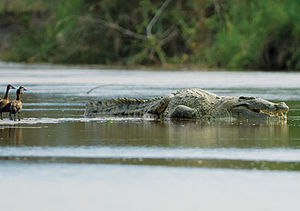
Gustave is a large male Nile crocodile from Burundi. He is notorious for being a man-eater, and is rumored to have consumed as many as 300 humans from the banks of the Ruzizi River and the northern shores of Lake Tanganyika. Though the actual number is difficult to verify, he has obtained near-mythical status and is greatly feared by people in the region.[1][2]
Gustave was named by Patrice Faye, a herpetologist who has been studying and investigating him since the late 1990s; much of what is known about Gustave stems from the film Capturing the Killer Croc, which aired in 2004 on PBS. The film documents a capture attempt and study on Gustave. Filmed in 2002, it is the only outstanding source of information on Gustave, and is available on Hulu.[1] [3]
Description
Since Gustave has not been captured, his exact length and weight is unknown. In 2002 it was stated that he could be "easily more than 20 feet (6 meters) long", and weigh more than a ton. Some estimates have put Gustave at 25 feet or more in length. When first observed, he was estimated to be around 100 years old in order to achieve such outstanding size; however, Gustave revealed a complete set of teeth when he opened his mouth. Since a 100-year old crocodile "should be nearly toothless" (according to the documentary), he was estimated to be "probably no older than 60, and likely, still growing".
Gustave is also known for the three bullet scars on his body. His right shoulder blade was also found to be deeply wounded. Circumstances surrounding the 4 scars are unknown. Scientists and herpetologists who have studied Gustave claim that his uncommon size and weight impedes his ability to hunt the species' usual, agile prey such as fish, antelope and zebra, forcing him to attack larger animals such as hippopotamus, large wildebeest and, to some extent, humans. According to a popular local warning, he is said to hunt and leave his victims' corpses uneaten.[2] Also, it was stated in his documentary film that since crocodiles can go several months without eating, one the size of Gustave could afford to select his prey carefully.
In parts of Asia and Australia saltwater crocodiles (Crocodylus porosus) of 6 metres (20 ft) long are occasionally reported; individuals of 9 metres (30 ft) long have also been reported. In eastern India the Guinness Book of World Records has confirmed the existence of a 7 meter individual.[4] Although Gustave is not the longest crocodile ever recorded, Nile crocodiles longer than him have not yet been reported.
Capture attempt
In Capturing the Killer Croc, Patrice Fey and other scientists attempted to capture Gustave. According to the film, Patrice had done two years of investigations before the capture attempt. However, Patrice and the scientists were given a 2-month time slot for capturing the beast; afterwards, a change of government would risk plunging the country into civil war. First, a trap cage weighing a tonne and nearly 30 feet in length was developed. The team then located Gustave and installed the cage and baited it -- and also placed a hidden infrared camera into the cage. Several different forms of bait were installed, yet none of them attracted Gustave or any other creature. The scientists also then installed three giant snares on strategic banks to increase their chances of capture; although smaller crocodiles were caught by the traps, Gustave wasn't.
In their last week of time before having to leave the country, the team then installed a live goat into the cage; but night after night were no results yielded. On one night, the camera gave out due to the stormy weather; the next morning, the cage was found partially submerged and sunken into the water whilst the goat had disappeared. It was speculated that the rising waters from the rain helped the monster to escape his hunters, or that the trap cage failed; but with no visual evidence as to what happened and now forced to leave Burundi due to political conditions, the team was only left to guess and will never know for sure what exactly happened that night.[1] [3]
Last reported sighting
As of May 2013, the last reported sighting of Gustave was in February 2008 by National Geographic sources.[5] A lack of subsequent reports makes Gustave's current status uncertain.
In fiction
Gustave is the basis of the film Primeval (originally titled Gustave), which follows a news team sent to Burundi to capture an exaggerated representation of Gustave.
See also
- Lolong, the largest crocodile in captivity until its death on February 10, 2013
References
- ^ a b c "PBS Previews Newsletter: Capturing the Killer Croc". PBS. May 12, 2004. Archived from the original on 2004-05-09.
- ^ a b McRae, Michael (March 2005). "Gustave: Have You Seen This Crocodile?". National Geographic Adventure. "Updated on 2007-01-08, 2007-04-19, and 2008-01-05"
- ^ a b "Capturing the Killer Croc".
- ^ "Guinness: India Park Home to World's Largest Crocodile; 23 Feet". Underwater Times. June 14, 2006. Retrieved 2010-12-12.
- ^ McRae, Michael (February 2008). "Gustave, the Killer Crocodile – Update". National Geographic Adventure Magazine. Retrieved 2010-07-27.